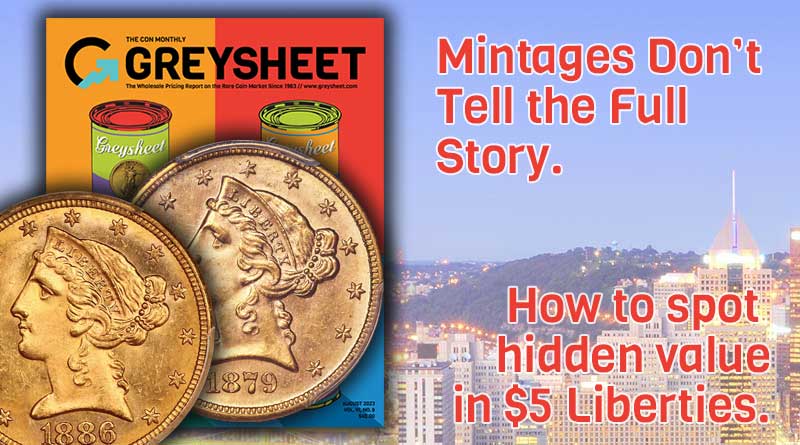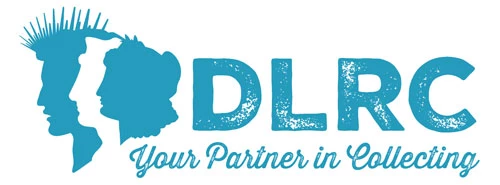Mintages don’t tell the full story. How to spot hidden value in the $5 Liberty series
While it won’t necessarily yield tremendous gains, there are approaches in searching for coins, currency, tokens, and medals that might realize future results that outperform those of other pieces available for the same price today.
Numismatists love to find coins, currency, or exonumia that
they can acquire at an under-appreciated price today and sell in the future
when there is a stronger demand and higher prices for them.
Those with advanced knowledge of a numismatic category may occasionally be able to pick up a desirable variety of a piece at the cost of the common version. Others can get ahead of the curve in studying a niche before a future research article or catalog popularizes that sector. Hope runs rampant among collectors of possibly acquiring a treasure at a common price which can later sell as a rarity.
While it won’t necessarily yield tremendous gains, there are approaches in searching for coins, currency, tokens, and medals that might realize future results that outperform those of other pieces available for the same price today.
Look at any price guide such as the Greysheet, Greensheet, or A Guide Book of United States Coins (popularly called the Redbook). Notice for most series of coins that there are a number of dates and mintmarks that list as the same basal (common-date) price in various grades. The same applies for many different varieties of U.S. currency types.
But, not all coins and currency listed at a common-date price are equally common. In fact, there are opportunities today to acquire significantly rarer issues at the very same prices or at not that much higher prices. If you can do the research to identify these potentially undervalued pieces, you can acquire items that have an edge for future value.
Mintage and printage figures don’t tell you the entire story of the current relative rarity of any coins or notes. The advent of third-party coin grading services in the 1980s, then currency grading services, made it possible to review population reports to get a much better idea of the relative survival rate of the various coin and currency issues.
In the current marketplace, PCGS and NGC are the most respected services in terms of their encapsulated coins trading on average closest to the prices in published price guides. Their affiliated currency grading services also have the highest respect in terms of value of the paper money they evaluate.
However, just like mintages don’t tell you the full story of the number of surviving specimens, the coin and currency population reports also don’t tell you the absolute relative rarity. The reason for that is that the cost of submitting coins to third-party grading services discourages collectors and dealers from sending in common coins in common condition. When doing statistical analyses of which numismatic treasures might represent the best current value, you need to keep this bias in the population reports in mind. A further factor to consider is that looking only at the population data for a specific grade is not as useful as checking the population data for that grade plus all higher grades of the issues.
In this column, let me use the With Motto Liberty Half Eagle gold coins to demonstrate the analyses I suggest. To do these analyses for coins, I recommend going online to access the PCGS and NGC population reports plus having access to prices guides or catalogs.
To demonstrate that mintage figures aren’t the only information you look at, compare the 1879-S and the 1908 $5 Liberty (using population information as of May 21, 2023):
|
Date |
Mintage |
Combined PCGS/NGC |
|
1879-S |
426,200 |
428 |
|
1908 |
421,874 |
13,963 |
Mintages of these two dates are similar, but there are more than 32 times as many of the 1908 $5 Liberty certified in MS60 and all higher grades by PCGS and NGC than there are of the 1879-S. In MS60 condition, Greysheet Bid on May 21, 2023 was $640 for the 1879-S and $590 for the 1908. In my judgment, the date with more than 32 times the rarity with a value only 8.5% higher represents the far better value.
In the Old West, the use of gold coins in everyday commerce was a common practice. Even when the government declared that merchants were legally required to accept unbacked paper money at par with gold coins, the businesses would tend to refuse repeat business with anyone who paid with currency. They might even take out an ad in the local newspaper to warn other merchants to avoid selling to people who paid with paper money.
Consequently, pre-1880 US gold coins largely entered circulation. Starting about 1893, a higher percentage of newly minted U.S. gold coins were kept in bank or central bank vaults as reserves, meaning that the number of surviving Mint State specimens is relatively greater.
In the With Motto $5 Liberty series, the 1900 date has the highest Mint State populations for MS60 and higher, MS61 and above, MS62 and nicer, MS63 and better, MS64 and higher, and MS65 and above. I did not analyze populations of MS66 and finer because there are far fewer of them, with each coin often priced on its individual merits.
As I went through the With Motto $5 Liberties, I found several Mint State issues where the Greysheet Bid catalog value was the exact same as for the 1900 date, but the combined PCGS/NGC population for that grade or higher was less than 1/10 that of the 1900. Here are the ones I located:
- 1881-S in MS63, MS64, and MS65
- 1885 in MS61, MS62, MS63, and MS64
- 1886 in MS60, MS61, MS62, and MS63
- 1887-S in MS63
- 1892 in MS63 and MS64
- 1893-S in MS60, MS61, and MS62
- 1894 in MS63 and MS64
- 1898 in MS63 and MS64
- 1898-S in MS60, MS61, MS62, and MS63
- 1899-S in MS60, MS61, MS62, and MS63
- 1900-S in MS60, MS61, MS62, and MS63
- 1902 in MS60, MS61, MS62, MS63, and MS64
- 1903 in MS60, MS61, MS62, MS63, and MS64
- 1905-S in MS60, MS61, and MS62
- 1906-S in MS60, MS61, MS62, and MS63
In my mind, the 1886, with a combined PCGS and NGC population in MS63 and all higher grades of just 205 coins should be a far more attractive coin than the 1900 with an MS63 and higher population of 18,784! Yet the Greysheet Bid MS63 value is $765 for both of them.
Just because coins may have the same catalog value in one reference does not mean that all guides will consider them to be of the matching value. Also, a coin such as the 1886 that seems to be extremely undervalued does not mean, if you can even find this date in this grade, that it would be available at the common-date price! Obviously, coins that are significantly rarer for the grade will be more difficult to find than the more common issues.
Beyond dates, mintmarks and grades that catalog for the same value as the 1900 $5 Liberty, I also found 25 other dates and mintmarks that may have a higher catalog value in one or more grades, but are so relatively close to that of the 1900 that they may well be worth paying a premium price to obtain it.The 1879-S $5 Liberty in grades MS60, MS61, MS62, and MS63 are one example. I leave it up to the readers to do their own research to identify the others.

Download the Greysheet app for access to pricing, news, events and your subscriptions.
Subscribe Now.

Subscribe to The Greysheet for the industry's most respected pricing and to read more articles just like this.
Source: CDN Publishing
Related Stories (powered by Greysheet News)
View all news
Dennis Rodman Trading Coins by Celebrity Mint™ to Debut at ANA 2025 World's Fair of Money

A pure gold Mike Tyson trading coin, originally gifted to UFC President Dana White at Fanatics Fest New York in 2024, has now gained a prominent spot in White's renowned $2 million card collection.

U.S. and world coins and bank notes show continuing strength in recent Scotsman Coins & Jewelry auction.









Please sign in or register to leave a comment.
Your identity will be restricted to first name/last initial, or a user ID you create.
Comment
Comments